Norway Residential Real Estate Market Analysis 2025
Norway's housing market is beginning to stabilise, as property demand gradually recovers amidst easing interest rates and a renewed pickup in dwelling starts. House price growth is now gathering pace. However, the broader economic outlook remains weak and uncertain.
This extended overview from Global Property Guide covers key aspects of the Norwegian housing market and takes a closer look at its most recent developments and long-term trends.
Table of Contents
- Housing Market Snapshot
- Demand Highlights
- Supply Highlights
- Rental Market
- Mortgage Market
- Historic Perspective
- Socio-Economic Context
Housing Market Snapshot
In Q2 2025, the nationwide house price index increased by 4.54% from the same period last year, following year-on-year growth of 6.49% in Q1 2025, 4.84% in Q4 2024, 3.26% in Q3 2024, 1.51% in Q2 2024, and 1.21% in Q1 2024, based on figures from Statistics Norway.
Norway's house price annual change:
Data Source: Statistics Norway.
Yet when adjusted for inflation, Norwegian house prices rose by a more muted 1.49% over the same period.
Quarter-on-quarter, nationwide house prices were up by 2.32% (1.13% inflation-adjusted) in Q2 2025.
During the year to Q2 2025:
- In Oslo, including Bærum, the house price index was up by 4.29% (1.25% inflation-adjusted), following a year-on-year increase of 2.48% in Q2 2024. Quarterly, house prices increased by a meager 0.29% (but declined by 0.88% when adjusted for inflation) in Q2 2025.
- In Stavanger, house prices rose strongly by 13.86% in Q2 2025 (10.54% inflation-adjusted), following a modest year-on-year growth of 3.61% in Q2 2024. Quarter-on-quarter, house prices were up by 3.6% in Q2 2025 (2.39% inflation-adjusted).
- In Bergen, the house price index increased by a robust 10.97% in Q2 2025 from a year earlier (7.74% inflation-adjusted), a sharp acceleration from the prior year's 2.62% growth. Quarter-on-quarter, house prices were up by 2.36% (1.16% inflation-adjusted) in Q2 2025.
- In Trondheim, house prices increased modestly by 3.17% in Q2 2025 from a year earlier (0.16% inflation-adjusted), an improvement from a minuscule growth of 0.29% in Q2 2024. During the latest quarter, house prices rose by 2.07% (0.87% inflation-adjusted) q-o-q.
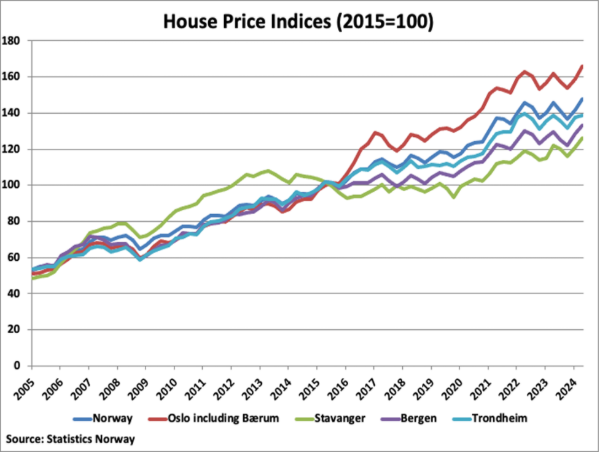
Demand is showing some signs of improvement. During 2024, the total number of residential property transactions rose slightly by 1.1% y-o-y to 89,672 units, following declines of 4.9% in 2023 and 9.3% in 2022 and an increase of 7.1% in 2021, according to figures from Statistics Norway. Then in the first quarter of 2025, residential property transactions in Norway increased by 18.3% to 18,561 units as compared to the same period last year. Though quarter-on-quarter, transactions fell by 24.7%.
Residential construction activity showed mixed results in the first half of 2025. Dwelling completions plunged by 15.4% y-o-y to 10,368 units in H1 2025, and dwellings under construction declined by 9.9% y-o-y to 34,812 units. In contrast, dwelling starts were up by 9.4% to 10,933 units over the same period.
In terms of overall economy, Norway's real GDP grew by a modest 2.1% during 2024, an improvement from the prior year's minuscule growth of 0.1% but still down from annual expansions of 3.2% in 2022 and 3.9% in 2021, according to Statistics Norway.
Last year's broad upturn was driven by a recovery in household consumption, increasing by 1.2% in 2024, in contrast to a 1.2% contraction in 2023. Likewise, net trade also contributed positively, with exports growing by 5.7% last year, a sharp improvement from a meager growth of 0.4%. Imports rose by 3.7% in 2024, in contrast to the prior year's 1.5% decline.
However, mainland GDP growth was recorded at just 0.6% in 2024.
The country's economic performance is projected to remain subdued in the coming years. Based on the latest forecast released by Statistics Norway, GDP is projected to contract by 0.2% this year, before registering minimal growth of 1.3% in 2026 and 1.1% in 2027. The mainland economy is expected to grow by 1.7% this year, 1.5% next year, and 2.1% in 2027.
Demand Highlights:
Property demand improving
During 2024, the total number of residential property transactions rose slightly by 1.1% y-o-y to 89,672 units, following declines of 4.9% in 2023 and 9.3% in 2022 and an increase of 7.1% in 2021, according to figures from Statistics Norway.
By property type:
- Detached houses: transactions were up by 3.8% y-o-y to 32,924 units in 2024, after falling by 4.8% in the prior year and 9.1% two years ago and rising slightly by 0.5% in 2021.
- Houses with 2 dwelling units: transactions increased by 2.3% y-o-y to 7,927 units last year, following decreases of 6.7% in 2023 and 9.5% in 2022 and a growth of 4.4% in 2021.
- Multi-dwellings: transactions were down slightly by 0.4% y-o-y to 38,518 units in 2024, following declines of 2.6% in 2023 and 9.7% in 2022 and an increase of 11.9% in 2021.
- Row houses: transactions declined only slightly by 0.6% y-o-y to 6,540 units last year, after falling by 9.3% in 2023 and 5% in 2022 and increasing by 11.3% in 2021.
- Other buildings: transactions dropped 4.8% y-o-y to 3,761 units last year, following contractions of 15.5% in 2023 and 11.6% in 2022 and a growth of 20.1% in 2021.
In the first quarter of 2025, residential property transactions in Norway increased by 18.3% to 18,561 units as compared to the same period last year. Though quarter-on-quarter, transactions fell by 24.7%.
Akershus, Oslo, Rogaland, and Vestland accounted for half of all residential property transactions in Norway in Q1 2025.
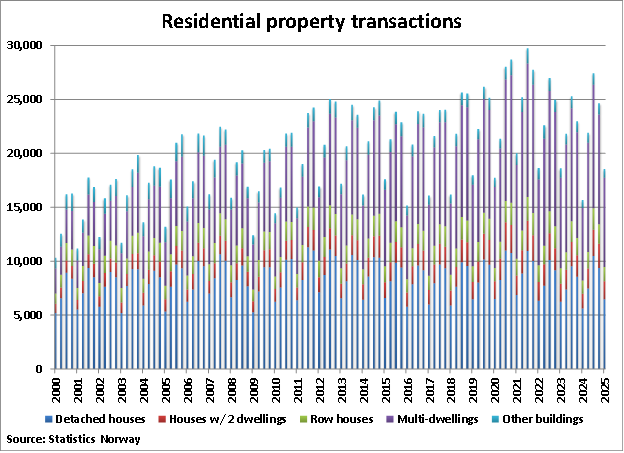
Supply Highlights:
Residential construction remains weak, but rising starts offer hope of recovery
All indicators from last year point to a depressed residential construction sector in the country.
- Dwelling starts plummeted by 17.5% y-o-y to 18,805 units in 2024, following declines of 23.6% in 2023 and 0.9% in 2022 and a meager growth of 0.7% in 2021, according to Statistics Norway.
- Dwellings under construction fell by 15.2% y-o-y to 35,137 units in 2024, after declining by 13% in 2023 and 0.2% in 2022 and rising a minuscule 0.4% three years earlier.
- Dwelling completions were down by 14.3% y-o-y to 23,986 units last year, its sixth consecutive year of decline.
Despite this, the uptick in dwelling starts in the first half of 2025 offers a glimmer of hope for recovery. During the period, dwelling completions and units under construction continued to fall, with completions down 15.4% y-o-y to 10,368 units and dwellings under construction declining by 9.9% y-o-y to 34,812 units. In contrast, dwelling starts were up by 9.4% to 10,933 units over the same period.

Even before the pandemic, the increase in dwelling starts and completions in Norway was modest in comparison to countries such as Ireland or Spain, despite the house price boom. Dwelling starts averaged 31,000 during the boom years from 2004 to 2007, then fell to 21,000 units annually from 2008 to 2010.
Dwelling starts rose again to an annual average of nearly 31,000 units from 2016 to 2023. Completions followed a similar pattern.
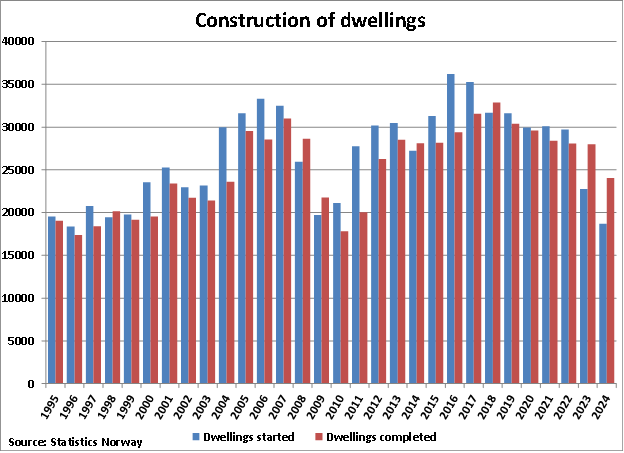
Dwelling stock growth decelerating
In 2025, there are currently 2,743,743 dwellings in the country, up slightly by 0.8% from a year earlier, according to Statistics Norway. This was a deceleration from the annual growth of 1% recorded in the past two years.
By property type:
- Detached houses: total stock rose by 0.3% y-o-y to 1,303,065 units in 2025, at par with the previous year's growth.
- Houses with 2 dwelling units: total stock increased by 0.3% y-o-y to 243,425 units, a deceleration from the prior year's 0.6% growth.
- Multi-dwellings: stock was up by 2% y-o-y to 717,058 dwellings this year, following an annual growth of 2.4% in 2024.
- Row houses: total stock increased by 0.8% y-o-y to 330,210 units this year, a deceleration from the previous year's 1.1% growth.
- Other buildings: total stock fell by 0.2% y-o-y to 75,651 units this year, following an annual contraction of 0.1% last year.
From 2014 to 2024, the stock has grown by an annual average of 1.2%. Almost half of the total dwelling stock are detached houses.

Rental Market:
Yields are low to moderate; rents continue to rise
Rental yields for residential properties in Norway are low to moderate, averaging 4.92% in Q2 2025, an increase from 4.19% in the same period last year, according to research conducted by the Global Property Guide. As in most markets, smaller properties typically offer higher rental yields as compared to larger ones.
After almost a decade of continuous house price increases in Norway, Oslo's residential property prices are very high, making Oslo one of the world's most expensive cities in which to buy a home, despite a decline in house prices in 2023. In terms of residential prices, we believe that Oslo is also one of the most expensive capital cities in Europe, and not surprisingly, has some of the lowest rental yields of any of Europe's capitals.
Norway's rent price index:
Data Source: OECD.
Nationwide, the average monthly rent for two-bedroom dwellings rose modestly by 4.1% y-o-y to NOK11,060 (US$1,080) in 2024, following annual growth of 7.5% in 2023, 3.7% in 2022, and 2.3% in 2021, according to Statistics Norway. Likewise, rents for three-bedroom dwellings increased by 5.4% y-o-y to an average of NOK12,980 (US$1,268) per month in 2024, following a growth of 6.6% in the preceding year.
In 2024:
- In Oslo (including Bærum), two-bedroom dwellings had an average monthly rent of NOK14,400 (US$1,407) while three-room dwellings cost NOK17,630 (US$1,722) monthly.
- In the municipality of Trondheim, two and three-room dwellings rent for NOK11,150 (US$1,089) and NOK13,430 (US$1,312), respectively.
- In Bergen, two and three-room dwellings rent for NOK10,660 (US$1,041) and NOK12,600 (US$1,231) per month, respectively.
- In Stavanger, rents averaged NOK10,310 (US$1,007) per month for two-room dwellings and NOK12,570 (US$1,228) per month for three-room dwellings.
- In Akershus county (except Bærum), two-room dwellings had an average monthly rent of NOK11,310 (US$1,105) while three-room dwellings cost NOK13,570 (US$1,325) per month.
From 2012 to 2024, residential rents in Norway have risen by an average of 56%.
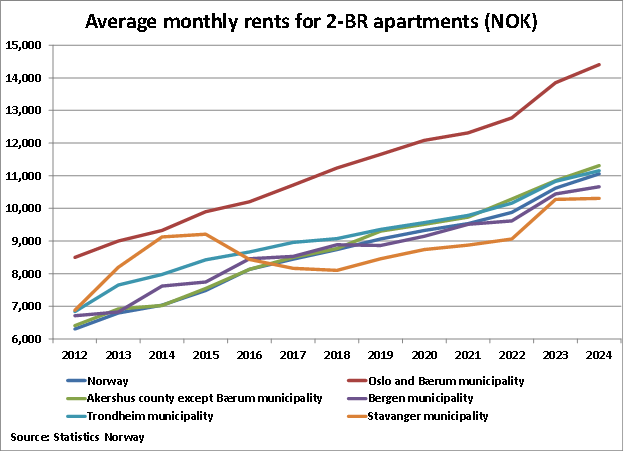
Mortgage Market:
Policy rate slashed; mortgage interest rates gradually decreasing
Norges Bank, the country's central bank, cut its key interest rate by 25 basis points to 4.25% in June 2025, after keeping it unchanged for eighteen consecutive months, amidst easing inflation and an uncertain economic outlook.
Norway's mortgage loan interest rates:
Data Source: Statistics Norway.
Prior to this, the central bank hiked its key rate fourteen straight times in less than three years, raising the borrowing costs to their highest level since 2008.
"Inflation has declined since the monetary policy meeting in March, and the inflation outlook for the coming year indicates lower inflation than previously expected. A cautious normalisation of the policy rate will pave the way for inflation to return to target without restricting the economy more than necessary," said Governor Ida Wolden Bache.
"The uncertainty surrounding the economic outlook is now greater than normal. If the economy takes a different path than currently envisaged, the policy rate path may be adjusted. But our objectives stand firm. We will finish the job and ensure that inflation is brought all the way back to 2 percent," added Governor Bache.
Nationwide inflation rate stood at 3% in June 2025, unchanged from the previous month but higher than the 2.6% recorded in the same period last year.
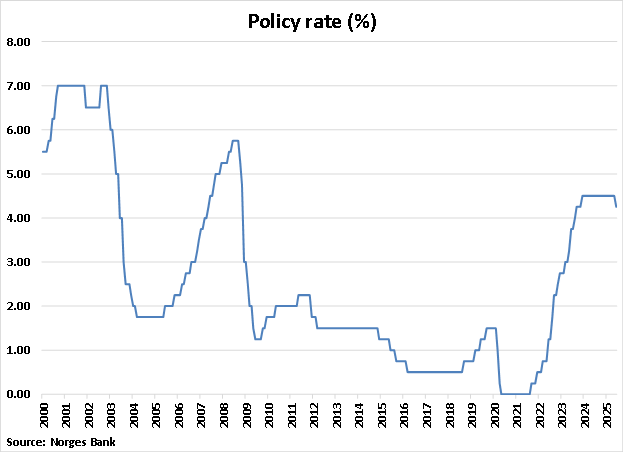
As a result, mortgage interest rates are now gradually declining. In May 2025, the average interest rate for new housing loans stood at 5.6%, down from the prior year's 5.72%, according to Statistics Norway.
In May 2025:
- Floating interest rate (Up to 3 months): 5.61%, down from 5.73% in the same period last year
- Fixed interest rate (More than 3 months): 5.02%, unchanged from the previous year
- Fixed interest rate (1-3 years): 4.99%, slightly down from 5.03% a year earlier
- Fixed interest rate (3-5 years): 5.06%, at par with the previous year's 5.07%
- Fixed interest rate (Over 5 years): 5.02%, higher than the 4.89% seen in the same period last year
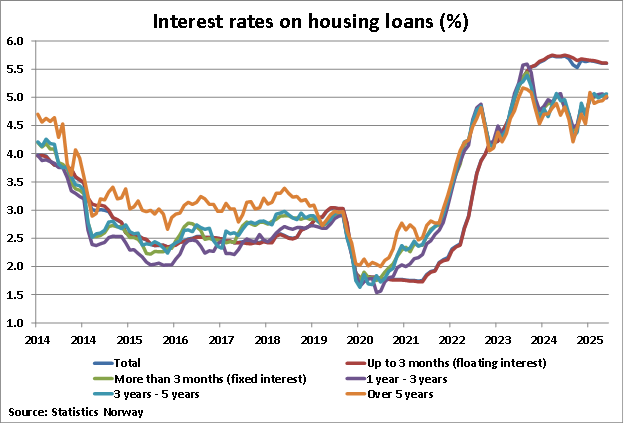
Mortgage loan regulations
Despite the recent rise in interest rates, they remain far below international standards, requiring the Ministry of Finance to keep a tight watch on lending. Norway has the third-highest level of debt-to-income among OECD nations at more than 230%, behind only Denmark and the Netherlands - almost double its level in 1995. "The high debt of Norwegian households still poses a significant risk to the economy and to jobs," said the Finance Ministry.
To restrain the increase in house prices, the government introduced tough new residential mortgage loan requirements, which came into effect on January 1, 2021, and shall apply until December 31, 2024. The regulation was evaluated in 2023.
The rules include:
- A borrowing cap of less than five times the borrower's gross income;
- Mortgages to last a shorter time;
- In Oslo, an equity requirement of at least 40% for secondary home buyers, as opposed to the 15% equity for first-time buyers;
- Lenders should make allowance for an interest rate increase of 5 percentage points when assessing a borrower's debt-servicing ability.
| NEW MORTGAGE LENDING REGULATIONS | |
| Maximum loan-to-value (LTV) ratio, installment loans | 85% |
| - Secondary dwellings in Oslo | 60% |
| Maximum LTV ratio, home equity credit lines | 60% |
| Required principal payments | Loans with an LTV ratio above 60% |
| Maximum debt-to-income ratio | 500% |
| Stress test of debt-servicing ability in the event of an interest rate increase | 5% |
| Flexibility quota | 10% |
| - In Oslo | 8% |
In December 2022, the Ministry of Finance decided to amend the regulation's requirement on debt-servicing ability to ensure that the customer has sufficient funds to cover regular expenses after an interest rate increase. At a minimum, the customer must be able to cover expenses if the interest rate is 7%, up from the current requirement of 5%. The amendments took effect on January 1, 2023.
The evolution of the requirements over time is shown in the table below:
| EVOLUTION OF REQUIREMENTS FOR RESIDENTIAL MORTGAGE LOANS | ||||
| Mar 3, 2010 - Nov 30, 2011 | Dec 1, 2011 - Jun 30, 2015 | Jul 1, 2015 - Dec 31, 2016 | Jan 1, 2017 - Dec 31, 2024 | |
| Maximum LTV ratio, installment loans | 90% | 85% | 85% | 85% |
| Maximum LTV ratio, home equity credit lines | 75% | 70% | 70% | 60% |
| Maximum LTV ratio, installment deferral | Unspecified | 70% | 70% | 60% |
| Maximum debt-to-income ratio | 300% | - | - | 500% |
| Stress test of debt servicing ability in the event of an interest rate increase | Unspecified | 5% | 5% | 5% (7% starting Jan 1, 2023) |
| The maximum rate of loans that can violate the regulation's requirements each quarter | - | - | 10% | 10% (8% in Oslo) |
| Maximum LTV ratio, secondary dwellings in Oslo | - | - | - | 60% |
Then, effective December 31, 2024, the Ministry of Finance adopted amendments to bank lending regulation. Notable changes include the following:
- The maximum LTV ratio for mortgages is increased from 85% to 90%;
- The debt-servicing capacity requirement has been revised to allow lenders to factor in the risk-mitigating benefits of fixed-rate loans;
- The debt-to-income (DTI) ceiling is maintained at its current level of 500%;
The regulation, which has contained a sunset clause since its inception in 2015 and has expired on December 31, 2024, will now be extended indefinitely based on the Financial Supervisory Authority's recommendation. The Ministry of Finance will, however, continue to assess the regulation periodically.
"The recent relaxation of the loan-to-value (LTV) limit for mortgages could increase financial vulnerabilities. Although households' debt burden has stabilized, it remains high. A higher LTV limit may fuel further increases in house prices and household indebtedness, contributing to higher financial stability risks, particularly if downside risks to growth or upside risks to inflation materialize," said the International Monetary Fund (IMF).
The IMF notes that achieving lasting improvements in housing affordability will require structural reforms to tackle the underlying factors keeping prices high, including the limited size of the rental market, scarce urban land, high construction costs, and a tax system that incentivizes mortgage borrowing. The IMF also added that phasing out mortgage interest deductibility and tightening access to subsidized mortgages would help temper speculative demand and improve fiscal efficiency.
As a percent of GDP, the size of the mortgage market is currently equivalent to more than 80%. DNB, Nordea, and Danske Bank are among the country's top mortgage lenders.

Historic Perspective:
Housing cycle: long house price boom and brief house price falls
Prices of existing dwellings in Oslo rose by a whopping 349% between 2000 and the first half of 2025 (144% inflation-adjusted). In Norway as a whole, existing dwellings rose by 297% (116% inflation-adjusted) over the same period.
During eight periods since 1990, house prices in Norway have risen by more than 10% annually, at least in nominal terms:
- Q1 1994 - Q4 1994: average y-o-y growth of 13.3% (11.8% in real terms)
- Q4 1996 - Q3 1998: 12% (9.4% in real terms)
- Q3 1999 - Q3 2000: 16.8% (13.6% in real terms)
- Q2 2004 - Q4 2004: 10.4% (9.2% in real terms)
- Q1 2006 - Q3 2007: 14% (12.3% in real terms)
- Q4 2009 - Q1 2010: 11.2% (8.8% in real terms)
- Q1 2010 - Q2 2013: 25.9% (20.4% in real terms)
- Q4 2013 - Q4 2022: 62.6% (29% in real terms)
Causes of these strong house price increases:
- strong economic growth
- low interest rates
Annual price falls were observed only in five brief periods:
- Q1-Q2 1993: -3.2% y-o-y (-5.6% in inflation adjusted-terms)
- Q2 2003: -1.1% (-3.2% in real terms)
- Q3 2008 - Q2 2009: -4% (-7.2% in real terms)
- Q1 2018: -1.1% (-3% in real terms)
- Q1-Q4 2023: -0.6% (-5.8% in real terms)
Between Q4 2023 and Q2 2025, prices of existing dwellings in Norway increased again by a cumulative 13.2% (8.2% in real terms).
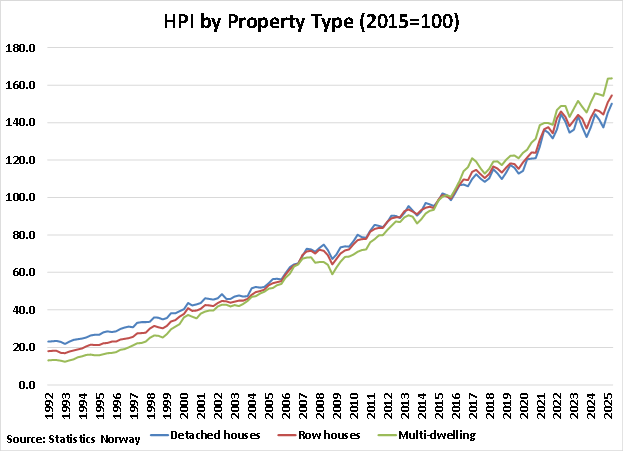
Bubble territory? Maybe in Oslo.
Is Norway experiencing a housing bubble? Normally, there is a clear pattern to housing bubbles, with house price rises greatly outpacing rent rises during the boom. In Norway, however, while the house price index (HPI) rose by about 50.8% from 2014 to 2024, the average monthly rent rose by 43.6% for one-bedroom dwellings and by 70.8% for dwellings with five bedrooms, based on the figures from Statistics Norway. This shows that there is no significant difference between house price and rent growth in the past decade.
However, in Oslo and its neighboring municipality, Bærum, house prices are outpacing rents. Oslo's HPI rose strongly by about 75.2% from 2014 to 2024, while average monthly rents rose by around 40.4% to 59.2% over the same period.
There are two main reasons why house prices are outpacing rental prices in Oslo:
- Many investors have purchased apartments to rent out, which keeps rent prices down.
- Owning a house is relatively cheaper than renting a property, argues Nordea's chief economist, Kjetil Olsen, and chief analyst Erik Bruce, partly due to the strong tax support for owning. He argues that it still makes sense to purchase a 30 square meter residence for NOK 3 million (US$293,000), rather than renting the same place.

Socio-Economic Context:
Owner occupancy is strongly subsidized by the state
State policy has had a strong impact on housing preferences in Norway:
- Preferential interest rates are offered to households through the State Housing Bank.
- Buyers can purchase municipal land at subsidized prices.
- Owner-occupiers get tax relief on mortgage interest payments.
- Owner-occupied housing is taxed at a lower effective rate than rental housing.
- Owner-occupied dwellings are capital gains tax-exempt.
The long-term impact of all these measures has been a massive shift in the structure of Norway's housing market. In 1920, 47% of Norway's households were renters. But recently, only 17.9% were renters, while around 70.6% were freeholders and 11.5% shareholders.
Oslo has the lowest proportion of homeowners at about 42.4%, while 25.9% of households in Oslo rent, with shareholders at 31.6% of total households.
At the same time, there is a consensus that the free market does not provide sufficient housing for the poor. Social rental housing made up around 15% of the total rental stock in Norway.
Norway's economic outlook remains subdued
During 2024, Norway's economy grew by a modest 2.1%, an improvement from the prior year's minuscule growth of 0.1% but still down from annual expansions of 3.2% in 2022 and 3.9% in 2021, according to Statistics Norway.
Last year's broad upturn was driven by a recovery in household consumption, increasing by 1.2% in 2024, in contrast to a 1.2% contraction in 2023. Likewise, net trade also contributed positively, with exports growing by 5.7% last year, a sharp improvement from a meager growth of 0.4%. Imports rose by 3.7% in 2024, in contrast to the prior year's 1.5% decline.
However, mainland GDP growth was recorded at just 0.6% in 2024.
"Demand from central and local government, high petroleum investment, and growth in mainland exports pulled up the mainland economy. A decline in investment in residential and commercial buildings, as well as subdued growth in private consumption, pulled in the opposite direction," said Pål Sletten, head of the National Accounts section at Statistics Norway.
The country's economic performance is projected to remain subdued in the coming years. Based on the latest forecast released by Statistics Norway, GDP is projected to contract by 0.2% this year, before registering minimal growth of 1.3% in 2026 and 1.1% in 2027. The mainland economy is expected to grow by 1.7% this year, 1.5% next year, and 2.1% in 2027.
"Risks to the growth outlook are tilted to the downside, while inflation risks are balanced. On growth, global tensions, including higher trade tariffs, could weigh on exports and investment, and continued tight financial conditions could further pressure highly indebted households and firms at a time when financial risks are elevated," said the IMF. "Over the longer term, demographic headwinds and the expected structural erosion of oil-related revenues will weigh on economic resilience."
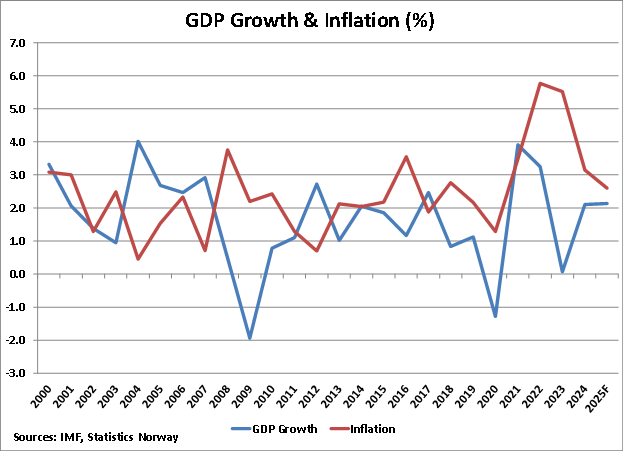
Economic growth averaged 1.2% from 2009 to 2019, before experiencing a contraction in 2020 due to the adverse impact of the Covid-19 pandemic.
Norway's petroleum sector remains a cornerstone of the economy, even as it reaches maturity, though it is currently navigating soft oil and gas prices. Brent crude spot price stood at US$71.44 per barrel in June 2025, down by 13.1% from a year earlier. It was far below the recent record-high US$122.71 per barrel seen in June 2022 but a huge improvement from the 22-year low of just US$18.38 per barrel it had reached in April 2020.
The petroleum industry is the country's largest industry, accounting for more than 20% of GDP, and around 47% of exports by value.

In June 2025, the nationwide unemployment rate increased to 4.8%, from 4.7% in the previous month and 4% in the same period last year. The country's jobless rate averaged 4% in the past decade.
"Both registered unemployment and LFS unemployment have increased recently. Unemployment is now slightly higher than projected in March, but still close to the level Norges Bank considers to be consistent with output at potential," said the central bank in its Q2 2025 Monetary Policy Report.
"While activity has picked up, which may indicate increased output, the number of unemployed has increased, which indicates that there may be a little more spare capacity in the economy. Continued solid employment growth indicates more labour market entrants, raising potential output," added Norges Bank.
Inflation remains above target. In June 2025, the nationwide inflation rate was 3%, unchanged from the previous month but up from 2.6% a year ago. It also remains higher than the central bank's target rate of 2%.
Nationwide inflation averaged just 2% from 2010 to 2020 before accelerating to 3.5% in 2021 and further to 5.8% in 2022. Inflation remained high at an average of 5.5% in 2023 before easing to 3.1% in 2024.
Krone continues to weaken versus euro amid partial recovery against the US dollar
The Norwegian Krone (NOK) has been under depreciation pressure in recent years following surprisingly high inflation.
In the past three and a half years, the krone lost approximately 15.6% of its value against the euro to reach an average exchange rate of NOK 11.853 = EUR 1 in July 2025. It also depreciated by 22% against the US dollar to reach NOK 11.338 = USD1 in January 2025, before clawing back about 11.6% over the next six months to average NOK 10.159 in July 2025.
Prior to this, the Norwegian Krone (NOK) had depreciated by about 29.6% against the euro, from NOK 7.3605 = EUR 1 in December 2012 to NOK 10.4612 = EUR 1 in December 2022. The krone lost 43.2% of its value against the US dollar over the same period, from NOK 5.6134 = USD 1 to NOK 9.8821 = USD 1 in December 2022.

Sources:
- House prices and house price indices (Statistics Norway): https://www.ssb.no/
- Price index of existing dwellings (Statistics Norway): https://www.ssb.no/
- Building Statistics (Statistics Norway): https://www.ssb.no/
- 06726: Transfers of dwelling properties with building, free market sale, by year and contents (Statistics Norway): https://www.ssb.no/
- Dwellings (Statistics Norway): https://www.ssb.no/
- Rental market survey (Statistics Norway): https://www.ssb.no/
- Gross rental yields in Norway: Oslo, Bergen and Trondheim (Global Property Guide): https://www.globalpropertyguide.com/
- Rate decision June 2025 (Norges Bank): https://www.norges-bank.no/
- Changes in the policy rate (Norges Bank): https://www.norges-bank.no/
- Interest rates in banks and mortgage companies (Statistics Norway): https://www.ssb.no/
- The lending regulation 1 January 2021 to 31 December 2022 (Government.no): https://www.regjeringen.no/
- Amendments to the lending regulation (Government.no): https://www.regjeringen.no/
- The lending regulation 1 January 2023 to 31 December 2024 (Government.no): https://www.regjeringen.no/
- Amendments to the lending regulation (Government.no): https://www.regjeringen.no/
- Monetary Policy Report 2/2025 (Norges Bank): https://www.norges-bank.no/
- Petroleum & Other Liquids (US Energy Information Administration): https://www.eia.gov/
- Norway: Staff Concluding Statement for the 2025 Article IV Consultation Mission (International Monetary Fund): https://www.imf.org/
- OECD Economic Outlook, Volume 2025 Issue 1 (Organisation for Economic Co-operation and Development): https://www.oecd.org/
- Economic trends (Statistics Norway): https://www.ssb.no/
- Weak growth in the Norwegian economy i 2024 (Statistics Norway): https://www.ssb.no/
- Labour force survey (Statistics Norway): https://www.ssb.no/
- Consumer price index (Statistics Norway): https://www.ssb.no/